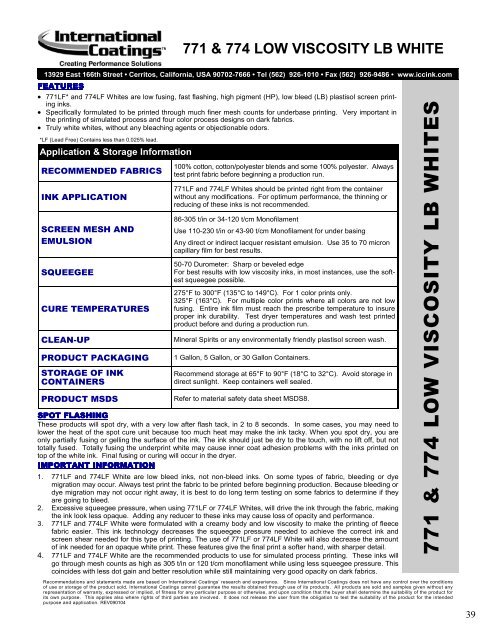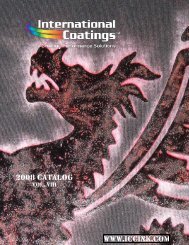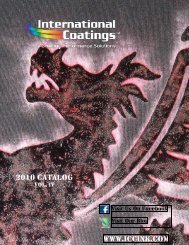2008 CATALOG WWW.ICCINK.COM
2008 CATALOG WWW.ICCINK.COM
2008 CATALOG WWW.ICCINK.COM
You also want an ePaper? Increase the reach of your titles
YUMPU automatically turns print PDFs into web optimized ePapers that Google loves.
13929 East 166th Street • Cerritos, California, USA 90702-7666 • Tel (562) 926-1010 • Fax (562) 926-9486 • www.iccink.com<br />
FEATURE EATURE EATURES<br />
EATURE<br />
� 771LF* and 774LF Whites are low fusing, fast flashing, high pigment (HP), low bleed (LB) plastisol screen printing<br />
inks.<br />
� Specifically formulated to be printed through much finer mesh counts for underbase printing. Very important in<br />
the printing of simulated process and four color process designs on dark fabrics.<br />
� Truly white whites, without any bleaching agents or objectionable odors.<br />
*LF (Lead Free) Contains less than 0.025% lead.<br />
Application & Storage Information<br />
RE<strong>COM</strong>MENDED FABRICS<br />
INK APPLICATION<br />
SCREEN MESH AND<br />
EMULSION<br />
SQUEEGEE<br />
CURE TEMPERATURES<br />
CLEAN-UP<br />
PRODUCT PACKAGING<br />
STORAGE OF INK<br />
CONTAINERS<br />
PRODUCT MSDS<br />
771 & 774 LOW VISCOSITY LB WHITE<br />
100% cotton, cotton/polyester blends and some 100% polyester. Always<br />
test print fabric before beginning a production run.<br />
771LF and 774LF Whites should be printed right from the container<br />
without any modifications. For optimum performance, the thinning or<br />
reducing of these inks is not recommended.<br />
86-305 t/in or 34-120 t/cm Monofilament<br />
Use 110-230 t/in or 43-90 t/cm Monofilament for under basing<br />
Any direct or indirect lacquer resistant emulsion. Use 35 to 70 micron<br />
capillary film for best results.<br />
50-70 Durometer: Sharp or beveled edge<br />
For best results with low viscosity inks, in most instances, use the softest<br />
squeegee possible.<br />
275°F to 300°F (135°C to 149°C). For 1 color prints only.<br />
325°F (163°C). For multiple color prints where all colors are not low<br />
fusing. Entire ink film must reach the prescribe temperature to insure<br />
proper ink durability. Test dryer temperatures and wash test printed<br />
product before and during a production run.<br />
Mineral Spirits or any environmentally friendly plastisol screen wash.<br />
1 Gallon, 5 Gallon, or 30 Gallon Containers.<br />
Recommend storage at 65°F to 90°F (18°C to 32°C). Avoid storage in<br />
direct sunlight. Keep containers well sealed.<br />
Refer to material safety data sheet MSDS8.<br />
SPOT SPOT FLASHING<br />
FLASHING<br />
These products will spot dry, with a very low after flash tack, in 2 to 8 seconds. In some cases, you may need to<br />
lower the heat of the spot cure unit because too much heat may make the ink tacky. When you spot dry, you are<br />
only partially fusing or gelling the surface of the ink. The ink should just be dry to the touch, with no lift off, but not<br />
totally fused. Totally fusing the underprint white may cause inner coat adhesion problems with the inks printed on<br />
top of the white ink. Final fusing or curing will occur in the dryer.<br />
IMPORTANT IMPORTANT INFORMATION<br />
INFORMATION<br />
1. 771LF and 774LF White are low bleed inks, not non-bleed inks. On some types of fabric, bleeding or dye<br />
migration may occur. Always test print the fabric to be printed before beginning production. Because bleeding or<br />
dye migration may not occur right away, it is best to do long term testing on some fabrics to determine if they<br />
are going to bleed.<br />
2. Excessive squeegee pressure, when using 771LF or 774LF Whites, will drive the ink through the fabric, making<br />
the ink look less opaque. Adding any reducer to these inks may cause loss of opacity and performance.<br />
3. 771LF and 774LF White were formulated with a creamy body and low viscosity to make the printing of fleece<br />
fabric easier. This ink technology decreases the squeegee pressure needed to achieve the correct ink and<br />
screen shear needed for this type of printing. The use of 771LF or 774LF White will also decrease the amount<br />
of ink needed for an opaque white print. These features give the final print a softer hand, with sharper detail.<br />
4. 771LF and 774LF White are the recommended products to use for simulated process printing. These inks will<br />
go through mesh counts as high as 305 t/in or 120 t/cm monofilament while using less squeegee pressure. This<br />
coincides with less dot gain and better resolution while still maintaining very good opacity on dark fabrics.<br />
771 & 774 LOW VISCOSITY LB WHITES<br />
Recommendations and statements made are based on International Coatings’ research and experience. Since International Coatings does not have any control over the conditions<br />
of use or storage of the product sold, International Coatings cannot guarantee the results obtained through use of its products. All products are sold and samples given without any<br />
representation of warranty, expressed or implied, of fitness for any particular purpose or otherwise, and upon condition that the buyer shall determine the suitability of the product for<br />
its own purpose. This applies also where rights of third parties are involved. It does not release the user from the obligation to test the suitability of the product for the intended<br />
purpose and application. REV090104<br />
39




